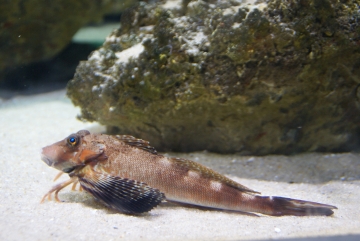760225_Sea Robins_360 px width.jpg

Some species of sea robins can use their "legs" to taste their prey in the sand. Credit: Laura Wolf, CC BY 2.0
It looks like something a six-year-old dreamed up in art class—the body of a fish, the “wings” of a bird, the legs of a crab, and even the taste buds of a human tongue. Throw in some loud croaks and grunts, and you’ve got one of the ocean’s many oddities: the sea robin.
The fish is found in warm waters around the globe—usually in shallow water with a sandy or rocky bottom. A typical adult is a foot or more long, although some species can reach twice that size. The fish have tapered bodies, and heavy skulls that help them poke around the bottom for food—shrimp, clams, crabs, and small fish.
When a sea robin swims, the fins on the sides of its body fan out like the wings of a bird—hence the name. As the fish matures, the “rays” at the front of these fins change. They form small “legs” that the fish uses to walk along the bottom.
But the legs are for more than just getting around. The fish uses them to feel out prey. And at least one species may use them to “taste” prey before they ever see it.
In a recent lab study, biologists buried some of the sea robin’s favorite foods below the sand and watched them feel it out. They then buried some of the chemicals produced by the prey. And they found that one species quickly dug up those goodies as well. The legs of those fish were coated with tiny sensory organs that are a bit like the taste buds on your tongue. They allow the sea robin to “taste” its food well before it even swallows it.

